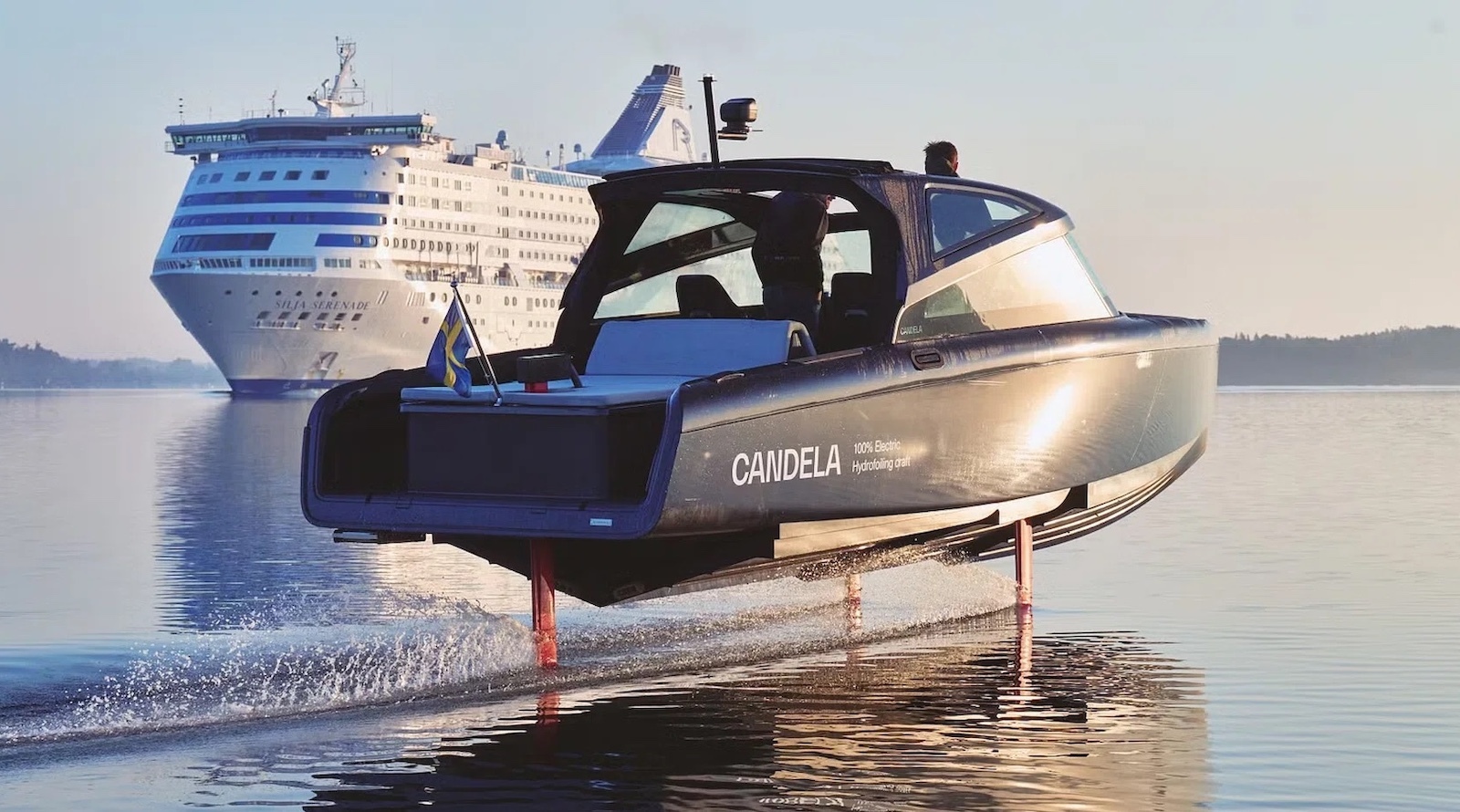While the much lower fuel cost has to be a bit of a shocker (we all know EVs are more efficient and cheaper to operate, but not 95% cheaper), the bigger surprise has to be how much more convenient the electric boat was in a certain key way. “We actually had range anxiety, but not for the Candela. The irony is that the photographer’s gasoline-powered chase boat had to refuel six times during the trip, while we only charged three times,” said Gustav Hasselskog.
Finally someone addressing the absurbd cost and emissions of illegally immigrating
Sanest Lemmy user.
I like the idea of this match, but I’m cautious about the article. All they say about the gas-powered boat is that it’s a similar size; they don’t mention the actual type of boat the chase boat was, and I didn’t see it in a brief skim of the video. I suspect that a notable percentage of the electric boat’s efficiency is due to its being a hydrofoil. If the gas boat is the standard hull-in-the-water, it would naturally be less efficient.
Big part of this would be that its a foiling boat and that massively reduces drag from the water. Keeping weight and drag down are the secret to improving efficiency for EVs be they boats or cars. Any decent marina its easy to get multiple 22kw shore supply as well, it can be expensive and metered but you aren’t going to be waiting that long to recharge your boat.
Electric makes the most sense on sail boats as they already have a green source of energy, and thanks to hydro they can convert some of that motion generated by the wind into charge for the batteries. Couple with solar and you start to look at a decent amount of energy generation.
Sail boats also tend to have far less powerful ICE than your average motor yacht, so you need less powerful EV motors to achieve the same speed, and in the right conditions you only really need the motor getting in and out of the harbor so your battery bank is smaller and lighter. Plus you could make the batteries do double duty as the house batteries as well.
The trick will be to get the super rich out of their shitty super yachts that burn a couple of thousand dollars of fuel per hour, they could already have sail boats but choose not to for the increased living space that they can get out of the same length of boat due to being able to build much higher due to no masts.
Admittedly it’s WAY easier to operate a motor boat than a sail boat, so depending on how you like to recreationally bleed your unlimited money I can see reasons for that choice.
But I fully agree that we’ve had renewable energy-based ships with unlimited range for millenia. The claim that “The aim was to demonstrate that zero-emission sea travel [is possible today]” broke my brain a little.
Super rich all have crewed boats, so its mostly to do with living space per foot of boat length or them as they just pay their way around the skill issue. Those who do like to occasionally pilot or race their own boat tend to have sailing boats as they are much more rewarding to sail.
The bits that are different between a motor and sail yacht is really just the sails, that part is actually pretty simple to learn (mastering is something else). In mast/boom mains, electric furling head sails, hydraulic or electric winches, all make operating the sails push button.
The navigation and marina skills are the same, if you have bow thrusters. As everything else is at a slower pace, sail boats are easier to get to grips with when under way and new to sailing.
I completely get that not everybody wants to tack their way upwind, but its the pleasure in actually sailing in silence rather than a noisy and smelly motor that is the reward here. That, and the cost saving. I can do two weeks sailing covering hundreds of nautical miles for £50 in fuel for a 40 foot sail boat and that’s with having to run the motor as a generator to charge the batteries (charter boats suck for house electrics and solar), vs. £500 ish for a motor yacht.
Hah. Your bar for “super rich” and mine may be in different places.
And you’re preaching to the choir, I’d much rather sail myself. But nerding out about the specifics aside, it’s very weird to leave it out of the renewable-powered sea travel conversation the way these guys are doing.
Super rich for me is being able to run a motor yacht that’s typically way over 100 feet with 4 or more crew on average of 100k each. Captain might be on anything up to 250k with a decent tonnage license and experience. High chance of a chase boat with its own separate crew.
The running costs of that boat would bankrupt even a decently wealthy millionaire in a year or two.
Rich is being able to run a modern 50 foot plus motor yacht for coastal cruising without a crew. Or a recent 50 foot sailboat with all the trimmings like an oyster.
But those are just my definitions.
I think idiots like bezos with his pathetic cosplay of a sailing boat that can’t even sail with more than one mast unfurled really don’t help the perception of sailing with the super rich.
We need more boats like the black pearl that can actually sail and be off grid on renewables for proper ocean crossing. Shame that most super rich just fly to their boat rather than actually crossing the oceans on them.
Sitting here reading about sail boats being easier to maneuver in harbors cause of bow thrusters, after having dealt with major prop walk just the other day in high winds while docking. The trick is keeping water moving past your rudder. Once your down to a knot or under things get dicey. Even with thrusters.
Such high winds impacts motor yachts as well, especially high sided ones. Most of the boats I’ve sailed are without bow thrusters require lines to manveur in even moderate winds in tight marinas. Bow thrusters makes it push button in moderate wind.
The trick will be to get the super rich out of their shitty super yachts
…and into the bottom of the ocean.
The dream
I don’t understand why sailboats have an advantage. What do they have for generating wind that the other boats don’t? All boats experience the same wind. Do the propeller+engine on a sailboat act as a generator when the boat moves with wind power?
So I was talking about hydro generators that go in the water rather than a wind turbine that rely on direct wind. I prefer the former as it doesn’t muck up the aero on the boat (sails can rob it of power with their dirty air) nor does it get in the way of the deck space that is often limited on a smaller boat. You could use both but I am not fan of wind turbines except at anchor.
With a normal sail boat its common to have more wind that you can safely handle with the boat, you can use the drag of a hydro generator, which goes in the water only when you need it, to help slow the boat down rather than reefing or reefing as much (intentionally making the sails smaller). As wind is the only thing generating motion for the sail boat, its free energy that you otherwise would not be using.
Motor boats rely on the motor to move them, so any drag means the motor has to work harder, imagine dragging a drogue (water parachute used as an anchor), its the same thing, its no longer free energy and you are actually spending more energy moving the same distance as the hydro generator doesn’t generate as much energy as it costs to use. Its the same problem for a wind turbine, as that increases aero rather than water drag for the motor boat, requiring more effort from the motor for the same speed & distance.
Motor yachts would be better switching their engine over energy generation as a generator for recharging the EV batteries. Indeed there are some bigger motor yachts that do exactly this as a backup to their solar and dock derived power.
Interesting bit about the surplus wind! I hadn’t thought of that, and didn’t know that boats can have a dedicated hydro generator device. Thanks!
Super easy to retro fit to be able to pull it out the water when its a light wind too, great for anybody wanting to reduce using their main engine as a battery charger.
Solar is great on sail boats but often the sails block the sun when they are out so its difficult to get full utilisation. Something like a hydro generator works perfectly with a good sized solar install for a sail boat to cover at anchor and under sail.
Boats with electric motors don’t need a dedicated generator, as the motor can act as a generator when you put it in neutral. (If properly configured.)
Sailboats can operate at lower power levels, because their displacement hull is efficient at low speeds. (Where a planeing hull needs higher speeds to get more efficient.) When I had solar electric sail boat, I could motor at 2 knots with no wind using only 500w of solar without touching the battery. I usually ran it at 3.5 knots if there was no wind, which gave me lots of range on battery for a full day on the water.
They also have the sail as a primary power source when there’s enough wind, so you don’t always need the electric motor. Sometimes, if the wind is strong enough, you can use the water turning the propeller to generate electricity to charge the battery. Or if the wind is light, you can use the motor to add more speed than sail alone, using less battery than using electric alone.
Isn’t this massively misleading? Comparing the fuel consumption to a chase boat that is not a hydrofoil, and blaming the efficiency on the fact that it is an EV?
A sail boat does the same distance for free
I actually would have typed that into my comment too, but i have no knowledge of how much slower a wind powered boat would travel upwind or how dependent performance would be on wind. I totally understand the need for mechanically powered transportation instead of using wind. My comment is mainly targeted at the misleading comparison.
213kWh feels like quite a lot of juice. Admittedly, I usually don’t go at planing speeds.
I have an 80Ah lead-acid battery to power the electric trolling motor on my inflatable dinghy. That’s 80A*12V = 0.96kWh. That gives me 5-10Nm range depending on speed. My dinghy would sink with 213kWh on board.
My 7 tonne sailboat uses ~2l/h of diesel at twice the speed. 213kWh of lead-acid would double the weight.
I’ve dealt with storing energy from solar for a long time now, and from the deepest part of my heart: fuck lead acid batteries. The only thing they have going for them is being able to charge below freezing. But they’re shit in every other way, especially weight.
They have one other advantage: unit price. But Lithium is rapidly catching up, and is already better if you calculate price per lifetime charge cycle.
Recyclability, too
deleted by creator
This says it uses the battery from a polestar. So it’s not lead acid but lithium. And 79kWh.
Replace the keel with lead acid batteries
That’s actually kind of genius. It’s even made of lead!
Just don’t run a shore on anything
Oh, flying ferry is a nick name for hydrofoil, not an actual aircraft.
Imaging your boat got on battery fire in the middle of the ocean :)
Imagine tanks full of highly volatile combustible fluids on fire in the middle of the ocean 🫨
_


That’s why most boat power systems use LiFePo4 (aka LFP) batteries instead of LiCoO2 like you phone battery. LFP is immune to thermal runaway, and can’t burn even if it did overheat.
Something something sharks?
Not mermaids? I feel tricked.
What would happen if the boat sank from its weight and you’re in the boat and you have this tremendously powerful battery, and the battery is now underwater, and there’s a shark that’s approximately 10 yards over there?









